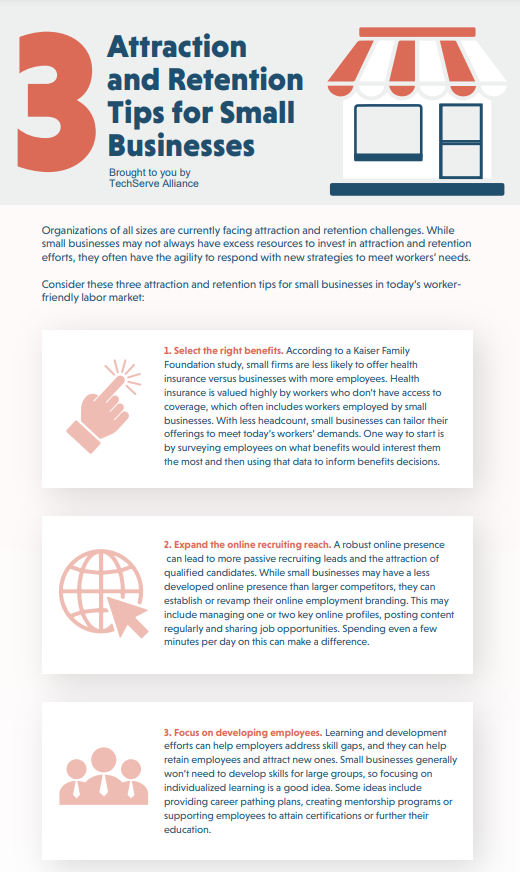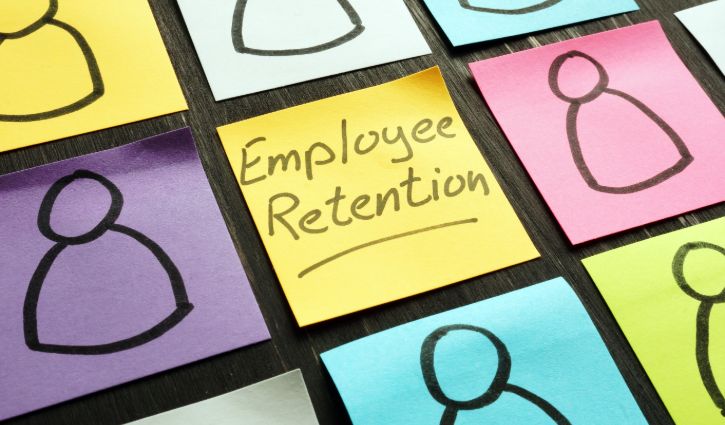Businesses of all sizes are currently facing attraction and retention challenges. Successful efforts to win over employees can require an investment of time and carry high costs. Unfortunately, small businesses often don’t have an excess of resources to invest in attraction and retention efforts in today’s worker-friendly labor market.
In what’s been labeled as the “great resignation,” an increasing number of employees are leaving jobs not only for better compensation and benefits but also to prioritize desires such as flexible work arrangements or career development opportunities. Losing an employee is particularly costly for small businesses, impacting both attraction and retention. Along with costs associated with recruiting, hiring and training a replacement, the employee that left was likely a key contributor in the smaller environment, potentially leading to a significant impact on the operations and culture of a workplace.
Amid these labor obstacles, smaller employers should focus on what’s feasible. Often, small employers have the agility to respond to the employment market with new strategies. This article highlights some attraction and retention tips for small businesses.
Select the Right Benefits
According to a study from the Kaiser Family Foundation, small firms are less likely to offer health insurance versus businesses with more employees. Health insurance is valued highly by workers who often don’t have access to this coverage, which often includes part-time employees, those in the service sector—and workers employed by small businesses. Thus, for small businesses, even simply offering packages that include health care can offer a competitive edge against those that don’t.
Health insurance is just one component to consider as part of a benefits package, and small businesses should tailor their offerings to meet the specific demands of current and prospective employees. One way to start this process is by surveying employees on what types of benefits would interest them the most and then using that data to inform benefits decisions. The best benefits to offer will vary in each small business depending on the needs of the workforce—but they can be leveraged to attract and attain the right employees.
Revamp Recruiting, Hiring and Onboarding Practices
Small businesses often have limited resources when it comes to recruiting, hiring and onboarding, so it’s important to be as efficient as possible. These restraints may include insufficient financial resources to put into these practices—but also a lack of time. Often, it’s an owner, manager or lone HR professional who also takes on recruiting duties. However, a thorough review of the current status of these practices may uncover ways to create improvements.
Leveraging technology is one way to improve these practices. The good news for smaller employers is that many tools available today are relatively feasible to set up—even for a team of one— and often cost-effective.
Employers can consider using tools such as an applicant tracking system that collects and stores candidate resumes and helps automate common recruiting and onboarding tasks. To further ease the onboarding process, employers could consider leveraging cloud-based and digital tools designed to help manage the process for completing Form I-9 or direct deposit, which can be tedious for both the new hire and the employer.
By improving these processes, employers can reduce costs, and recruiting efforts can focus on finding new employees rather than dealing with tedious tasks. Every employer will be at a different place in terms of their existing processes and their current operational challenges, but a best practice to get started is to focus on what the current pain points are and how they can be improved.
Expand Recruiting Reaches
If an employer isn’t receiving the number of quality job candidates they desire, it’s worth strategizing to grow this pool. A good starting point for small businesses looking to grow their recruiting reach is to expand their online presence. This may include creating and maintaining multiple online profiles, posting content regularly and educating prospective workers about job opportunities. If limited by time, it’s OK to focus on managing one or two key profiles. It’s best to pick a platform where potential employees may likely be and focus on developing an active presence—even if it just means putting in a few minutes per day.
Employers can also focus on managing how potential candidates view their employer brand—or reputation as an employer. While small businesses may not have as developed an employer brand as their larger competitors, they may have more agility to establish—or revamp—their branding. An example of this could be to focus on highlighting the core values and impact of their organization. Surveys find that a majority of employees are more likely to work for an organization with values that align with their own.
These illustrate a few ways small employers today are expanding their reach into the employment market. Ideally, the right strategies can lead to more passive recruiting leads and improved efforts to attract employees.
Focus on Developing Employees
Attraction and retention challenges aren’t always about bringing enough employees through the doors—today, many small businesses face skills gaps. In fact, a survey in 2020 from GetApp found that one in five small businesses cited a lack of employee skills as the single biggest challenge they faced in response to COVID-19. For example, an employer’s workforce might lack the skills to use technology effectively. These gaps could also exist with soft skills, such as communication abilities or emotional intelligence. While a solution to this may be to recruit for specific skills to close these gaps, existing employees are often overlooked. While recruiting for talent with desirable skills may require significant resources, small businesses should also consider how they can bridge these gaps in-house.
Small businesses generally won’t need to develop skills for large groups, so it’s a good idea to focus on individualized learning. Some ideas or opportunities include providing career pathing plans, creating mentorship programs, offering microlearning workshops to focus on a specific skill, or paying for employees to attain certifications or further their education outside of the workplace.
Learning and development efforts can not only help employers address skills gaps; they can help employers retain existing employees and even attract new ones. Surveys find that employees are more likely to stay with an employer if they feel the organization is investing in their careers. Putting a plan to action can not only help win over employees but help prepare an employer for its future talent needs.
Offer a Flexible Work Environment
Throughout the COVID-19 pandemic, many employees have been afforded the opportunity to work remotely or have flexibility with their schedules. Surveys overwhelmingly indicate that many employees prefer to retain flexible work options. These offerings include work-from-home arrangements, hybrid work schedules (working part of the week in the office and part of it remotely) or flexible work schedules. If a business has primarily administrative employees, remote or hybrid work could continue to be an option even as COVID-19-related precautions loosen. For small businesses, offering these types of arrangements can help maintain a competitive edge over competitors that don’t offer such flexibility.
However, not all organizations allow for remote or hybrid work. If a small business is in the service industry, for example, remote work may not be an option. Yet, even working with employees to create flexible scheduling options can go a long way. The feasibility of a small business being able to offer these types of flexible arrangements will vary, but these offerings remain a priority for many workers today.
Create a Strong Workplace Culture
While topics such as compensation and benefits matter for attracting and retaining employees, so does the culture of a workplace. Even if they have limited resources, small employers should focus on fostering a desirable workplace. A healthy company culture can help retain employees—and, in turn, create an environment that is attractive to prospective job seekers. In fact, company culture is important enough that it often drives employment decisions.
As such, many small businesses are focusing on creating a strong workplace culture. Leaders are pursuing initiatives such as training managers on how to identify employee burnout, designate fair workloads and support the needs of their individual team members. In addition, many small businesses are developing programs to help create an inclusive work environment.
These types of efforts can help foster a healthy workplace culture. Each small business will be at a different place concerning the current and desired state of their work environment—and leaders can consider what types of efforts can help bridge this gap.
Employer Takeaway
Like most organizations, small businesses face a set of challenges with attracting and retaining the employees they need. Fortunately, smaller businesses have the ability to stay agile and should consider what strategies they can leverage to compete in today’s labor market.
5 HR Trends to Monitor
Human resources (HR) departments are given more responsibility each year, often with budgets that don’t match these changes. As a result, HR teams must constantly innovate and stay on top of trends to remain competitive in today’s labor market.
This article highlights five HR trends for employers to follow.
Hybrid Workplace Sustainability
At this point in the pandemic, it appears the hybrid workplace is here to stay for many employers. According to a Gartner survey, 95% of HR leaders expect that at least some of their employees will work remotely after the pandemic. As such, many employers are shifting their perspective of hybrid work from a novelty to the new standard in 2022. This means adapting and tailoring policies and processes to support hybrid work and equally accommodating all employees. For example, employee communications could be available on a digital destination that everyone can access, or video meetings could become the new standard regardless of location.
2020 and 2021 focused on companies’ agility and adaptability to remote and hybrid workplaces. Now, organizations are shifting their focus toward creating a sustainable work model that meets the needs of both their business and employees in 2022 and beyond.
Attraction and Retention Amid Labor Shortages
Employee attraction and retention have become major obstacles for most employers and will likely continue through 2022. In fact, 67% of employers today consider attraction and retention somewhat of a challenge, according to Zywave’s 2021 Human Resources Benchmarking Overview. And that isn’t going to simply disappear.
Employers face several unique employment challenges in the current employment market, including the following:
- Workers fear contracting a severe case of COVID-19 on the job.
- Workers have built up comfortable savings to hold out for a desirable job.
- Workers reprioritized their job desires, such as scheduling flexibility, telework options, access to employee benefits, greater compensation and job fulfillment.
- Workers face continued caregiving duties, which require them to remain at home.
Industry research predicts that as the pandemic progresses, many employees will voluntarily leave their jobs for better compensation, benefits and workplace environment factors—such as work-life balance and remote or hybrid arrangements.
The Zywave survey revealed that employers are already planning to meet these employee needs and hold on to talent as the pandemic evolves. Employers are exploring the following strategies:
- 62%—Evaluating compensation
- 45%—Offering greater workplace flexibility
- 40%—Offering more upskilling and development opportunities
- 38%—Expanding benefits offerings
Many employers have leveraged these strategies to meet the current needs of employees. If organizations haven’t already started exploring strategies to do so, they will likely have to play catch-up quickly in 2022.
Increased Investment in HR Technology
Many employers are leveraging HR technology to automate their processes and create efficiencies. Technology doesn’t remove the human aspect from HR but rather enhances it. When HR departments use technology to create efficiencies, they can shift their focus from administrative tasks to the actual employees. Here are some of the latest trending HR technologies for 2022:
- Cloud-based workplace management
- Employee benefits administration
- Employee self-service portals
- HR automation
- Learning and development
- Onboarding and offboarding
- Virtual recruitment
Especially in today’s competitive market for top talent, employers could benefit from using technology to make the recruiting and hiring processes more efficient. Recruiters can use automation software and artificial intelligence to source, screen and schedule candidates. Additionally, chatbots are a popular tool to help employers better qualify candidates before any human interaction—and that trend will likely continue this year.
Growing Demand for New Skill Sets
Just as workplaces change, workers’ skills do too. According to Gartner data, the number of skills required for a single job increases by 10% per year, and new skills replace old ones. Organizations are embracing a dynamic approach to reskilling talent to shift vital employee skills and help develop skills as they become relevant. As an example of how the market has shifted, 1 in 3 skills in an average 2017 job posting in IT, finance or sales are already outdated.
The necessary skill sets will vary by organization and industry, but some employers are pursuing and supporting the following general proficiencies for potential and current employees:
- Communication—Employee communication skills are critical for emails and virtual meetings, especially in a remote or hybrid workplace. The goal remains to be effective and efficient, and top talent can communicate clearly and concisely with all stakeholders.
- Digital capabilities—Tying into the communication aspect, an employee should be open to using digital communication platforms at work and know when to use specific platforms.
- Emotional intelligence (EI)—Employees with higher EI typically navigate the workplace more effectively and are more resilient. Components of EI include empathy, motivation, self-awareness, self-regulation and social skills.
These skills were important before the pandemic but may not have been prioritized by many organizations. Organizations can seek out and hire candidates who demonstrate these skills but can also push current employees to convey or demonstrate these skill sets to leverage more work opportunities within the company. Moving through the new year, successful employers can shift their focus from roles to skills that can make the organization competitive and innovative.
Continued Focus on Employee Health and Well-being
Regardless of worksite location(s), employee health and safety will remain a top concern and priority for both employers and employees. To ensure employees feel safe in the workplace, employers can accommodate requests for remote work and offer on-site alternatives. Since the pandemic began, employers may have been more reactive but can and should shift to being proactive about employee well-being and support in 2022.
From a holistic perspective, employee mental well-being will also remain a priority for organizations. It’s been nearly two years since the pandemic began, and many employees still struggle to find a healthy work-life balance. Caregiving, nurturing mental health and adjusting to remote work will likely remain top issues for employers to address. Employers that embed well-being across all essential people practices will likely best defend and support health and wellness for the workforce.
Employers can get ahead of the game by monitoring the trends that will impact the workplace and resonate with the current workforce. Many HR functions were quickly reimagined in 2021, but there are ways to elevate those strategies to be sustainable in 2022 and beyond. Contact us today to learn more about attraction and retention or for additional resources on any of the topics discussed in this article.
Although small businesses face employee attraction and retention challenges, they can adapt and compete in today’s tight labor market with the agility to respond with new strategies to meet workers’ needs.












